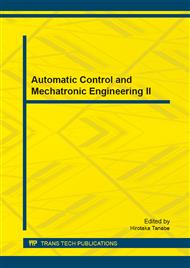p.26
p.30
p.34
p.38
p.45
p.52
p.60
p.65
p.68
Movable Virtual Wall for Operation of Master-Slave Manipulator Arms
Abstract:
This research work is to develop a concept of movable virtual wall for miniature tasks operation of a master-slave manipulator arm with force reflection. The purposes are to improve accuracy of the operation and preventing over travelling beyond a desired boundary. The predicted distance of the end-effector can be calculated based on various end-effector and hand models. From the experiments, movable virtual wall shows adjusting some wall parameters, the over travelling through the forbidden boundary can be prevented and the possibility of further development to improve miniature tasks operation.
Info:
Periodical:
Pages:
45-51
Citation:
Online since:
September 2013
Authors:
Keywords:
Price:
Сopyright:
© 2013 Trans Tech Publications Ltd. All Rights Reserved
Share:
Citation:


